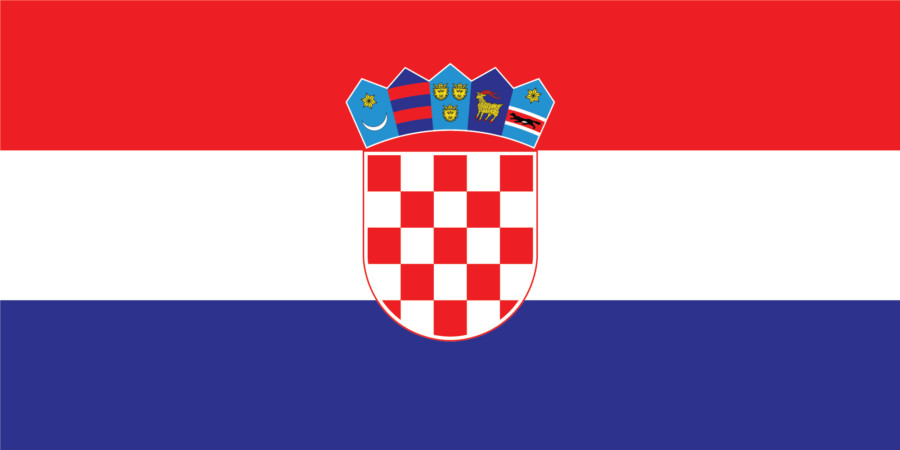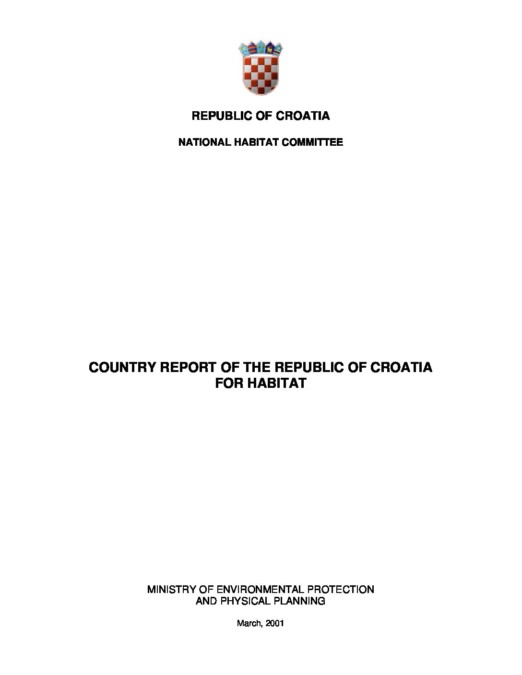
Croatia
Urban indicators:
| Value | Year | ||
| Surface area (sq km) | 56594 | 2014 | |
| Population (proj., 000) | 4225 | 2016 | |
| Pop. density (per sq km) | 75.5 | 2016 | |
| Capital city | Zagreb | 2015 | |
| Capital city pop. (000) | 687 | 2015 | Refers to the settlement of Zagreb. |
| Population growth rate (average annual %) | -0.4 | 2010-2015 | |
| Urban population growth rate (average annual %) | 0.1 | 2010-2015 | |
| CO2 emission estimates (000 tons/tons per capita) | 17712/4.1 | 2013 | |
| Population using improved drinking water sources (urban/rural, %) | 99.6/99.7 | 2015 | |
| Population using improved sanitation facilities (urban/rural, %) | 97.8/95.8 | 2015 |
| 1995 | 2005 | 2014/2015 | |
| Urban population ('000) | 2,575 | 2,476 | 2,509 |
| Level of urbanization (%) | 54.9 | 56.4 | 59.0 |
National Report:
National Report Executive Summary:
In streamlining its spatial development, the Republic of Croatia has the following national documents in place for an integrated planning approach: Spatial Development Strategy of the Republic of Croatia (1997, Amendments in 2013) and Spatial Development program of the Republic of Croatia (1999, Amendments in 2013). The Strategy and the Program promote a more harmonious development of the Croatian urban system, and put special emphasis on encouraging the development of medium and small sized cities and development centers as holders of the development system, while also proposing a slowdown of population growth in large cities.
Due to negative demographic processes and an underdeveloped network of settlements, uses and economy, they particularly highlight areas of limited development. Under the Spatial Development Strategy, Croatia opted for a polycentric concept of development, but this has not yet been fully implemented. The policy of polycentric development remained incomplete partly because of a too-brief time period planned for its implementation, partly due to sectoral misalignment of development plans, and partly due to a non-existent system for monitoring implementation. Having ensued from war destruction and the economy’s restructuring, the processes of population displacement, abandonment of rural areas and islands, neglect of arable land and economic resources after independence also did not serve to aid polycentric development. Concurrently, there was a migration in large cities, especially their fringe areas, and in attractive coastal regions. With the entry into force of the 2014 Physical Planning Act began the process of drafting a new Spatial Development Strategy of the Republic of Croatia to become a fundamental strategic document that will determine priorities for spatial development and streamline their implementation.
Demographic trends of the Republic of Croatia in the past 15 years, continuing earlier ones, are characterized by a decline in population, continuous natural depopulation, increased aging of the population and an imbalance in the population’s age structure. The Republic of Croatia is one of a group of only five EU countries that in the period of 2008 - 2012 recorded both natural decline and negative balance of migrations. According to the last census of the population, households and apartments in 2011, 4,284,889 people lived within the territory of the Republic of Croatia. Compared to the previous census from 2001, the population shrank by 152,571 persons, or an index of 96.56. Demographic aging of the population has been recorded for a long time, and has a tendency of rising. Depopulation processes are less evident in the attractive coastal areas recording coastal urbanization as well as in the metro region of the capital, Zagreb.
Croatia’s regional urbanization is uneven. Coastal macro-regions are urbanized at an above average level. This came as a consequence primarily of migrations from the hinterland and the islands to cities, as well as of higher natural growth in the first and partially second generation of rural-to-urban settlers. On the other hand, macro-regions in continental Croatia, being less urbanized, have different features. The development of Zagreb and other cities in the mainland was facilitated by their extensive economy (developed manufacturing and service activities), which has driven migrations from rural areas and a social restructuring of the agricultural population.
Statistics:
Urban housing indicators
Urban population with access to adequate housing (%)
Basic services and infrastructure
Urban population with access to safe drinking water (%)
Urban population with access to adequate sanitation (%)
Urban population with access to regular waste collection (%)
Urban population with access to clean domestic energy (%)
Urban population with access to public transport (%)
Level of effective decentralization
Share of local authorities’ expenditure financed from local revenue (%)
Indicators for urban policies, legislation and economy
Local authorities having implemented urban policies supportive of local economic development and creation of decent jobs and livelihoods (%)
Local authorities having adopted or implemented urban safety and security policies /strategies (%)
Local authorities having implemented plans and designs that are inclusive and respond to urban population growth adequately (%)
Statements by Croatia:
-
Habitat III Plenaries



